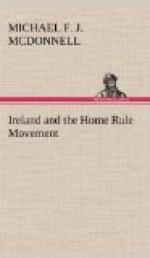The Report was in favour of purchase as the only possible policy to be carried out on such terms that the yearly payments of the tenants should be 15 to 25 per cent. lower than second term rents, while the sum received by the landlords was to be such as at 3 or 3-1/4 per cent. interest would yield them the same income as second term rents, less 10 per cent. deduction, as an equivalent for the cost of collection under the old system. The difference between these two sums was to be bridged by a bonus from the Treasury to the landlords in the interests of agrarian peace. The Report was further in favour of enlarging small holdings by dividing up grazing lands, and under it evicted tenants who, as such, were not entitled to have judicial rents fixed were to be given the option to purchase.
Second term rents are those fixed for the second judicial period of fifteen years under the Act of 1881, and they were on an average 37 per cent. less than those before the passing of that Act.
Under the Act which Mr. Wyndham introduced on March 25th, 1903, the Treasury may advance a sum up to one hundred millions at 2-3/4 per cent. interest, with another 1/2 per cent. sinking fund. The advances to the tenants, which are limited to L5,000 or, in exceptional circumstances, L7,000, are made in cash by the Land Commissioners, of whom three, serving as the Estates Commissioners, are expressly responsible for the working of the Act. A Treasury loan at 2-3/4 per cent. provides the necessary funds. Under the Act the issue of this Stock was limited to five million pounds a year for the first three years, but in January, 1905, this was changed to a sum of six million. By adding to the 2-3/4 per cent. interest which the tenants pay on the loan the further sum of 1/2 per cent. which they contribute to sinking fund for repayment, we arrive at 3-1/4 per cent. which they have to pay for sixty-eight and a half years to obtain the fee-simple of their land. The security which Mr. Wyndham produced for the repayment of interest was the credit of the Irish peasantry, of whom, out of more than seventy thousand purchasers owing an eighth of a million to the State under previous Purchase Acts, only two had incurred bad debts, which, as being irrecoverable, had fallen on the taxpayer. As a further safeguard the payment is secured by the annual grants-in-aid paid by the Treasury to the County Councils, which can be withheld on default to pay interest on purchase advances. In order to facilitate sales the system of “zones,” which has been so much canvassed, was devised. Under it the Estates Commissioners are bound to make advances of purchase-money in all cases in which the total annuity paid by the tenant ranges from 10 to 40 per cent. less than the rent which he has hitherto paid. If it be a first term rent the reduction must be at least 20 and not more than 40 per cent. less, and if it be a second term rent there must be a reduction of not less than 10 and not more than 30 per cent. It will be, perhaps, clearer if put in this way. If a first term rent amounts to L100, then the tenant-purchaser has to pay at least L60, and at most L80, as annuity, while if the L100 represent second term rent the yearly payment varies from a minimum of L70 to a maximum of L90.




